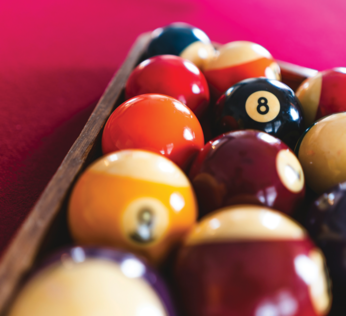Pool simulation with Go and Fyne
Programming Snapshot – Go Pool Simulation
To improve his skill at the pool table, Mike Schilli sets out to program a simulation in Go using the Fyne framework.

If you just aim by the seat of your pants at the pool table in the pub, the results will vary between brilliant and downright embarrassing. That's why I decided to finally learn the angle at which you have to hit a ball so that it heads off in the right direction, straight for the pocket. To do this, I studied Poolology [1], which explains the strategy in detail. I don't have a pool table at home to practice on, so I wondered: How difficult would it be to write a graphical simulation of the pool balls in Go? That way I could try out the technology onscreen before challenging the biggest pool hustlers in the wickedest pool halls of San Francisco.
In the simplest of cases, pool players shoot the cue ball straight into the ball to be played, and the cue ball hits the colored ball right in the middle (you hope). The colored ball absorbs the energy of the cue ball and moves in the same direction, while the cue ball remains stationary – unless you used a trick such as spin. Things become more complicated if you hit a colored ball at an angle. In that case, it will shoot off to the side while the cue ball keeps moving along a deflected path. The angles here depend on the amount of overlap with which the colored ball was hit. In more concrete terms: If a pool player does not aim at the center of a ball but exactly at its edge (called a half-ball), the colored ball drifts away at an angle of about 30 degrees.
[...]
Buy this article as PDF
(incl. VAT)
Buy Linux Magazine
Subscribe to our Linux Newsletters
Find Linux and Open Source Jobs
Subscribe to our ADMIN Newsletters
Support Our Work
Linux Magazine content is made possible with support from readers like you. Please consider contributing when you’ve found an article to be beneficial.

News
-
Parrot OS Switches to KDE Plasma Desktop
Yet another distro is making the move to the KDE Plasma desktop.
-
TUXEDO Announces Gemini 17
TUXEDO Computers has released the fourth generation of its Gemini laptop with plenty of updates.
-
Two New Distros Adopt Enlightenment
MX Moksha and AV Linux 25 join ranks with Bodhi Linux and embrace the Enlightenment desktop.
-
Solus Linux 4.8 Removes Python 2
Solus Linux 4.8 has been released with the latest Linux kernel, updated desktops, and a key removal.
-
Zorin OS 18 Hits over a Million Downloads
If you doubt Linux isn't gaining popularity, you only have to look at Zorin OS's download numbers.
-
TUXEDO Computers Scraps Snapdragon X1E-Based Laptop
Due to issues with a Snapdragon CPU, TUXEDO Computers has cancelled its plans to release a laptop based on this elite hardware.
-
Debian Unleashes Debian Libre Live
Debian Libre Live keeps your machine free of proprietary software.
-
Valve Announces Pending Release of Steam Machine
Shout it to the heavens: Steam Machine, powered by Linux, is set to arrive in 2026.
-
Happy Birthday, ADMIN Magazine!
ADMIN is celebrating its 15th anniversary with issue #90.
-
Another Linux Malware Discovered
Russian hackers use Hyper-V to hide malware within Linux virtual machines.

